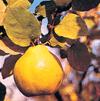- quince
-
/kwins/, n.1. either of two small trees, Cydonia oblonga or C. sinensis, of the rose family, bearing hard, fragrant, yellowish fruit used chiefly for making jelly or preserves.2. the fruit of such a tree.[1275-1325; ME quince, appar. orig. pl. (taken as sing.) of quyne, coyn < MF cooin < L cotoneum, akin to cydonium < Gk (mêlon) Kydónion quince, lit., (apple) of Cydonia]
* * *
Common quince (C. oblonga) is native to Iran, Turkey, and perhaps Greece and the Crimea. The raw golden-yellow fruit has a strong fragrant aroma and astringent taste; it takes on a pink colour when cooked and makes an excellent preserve. The Japanese quince (Chaenomeles species) is an ornamental shrub widely used for its flowers, which appear on the tightly branched stems before the leaves open fully in late winter and early spring. Quince (Cydonia oblonga).Walter Chandoha
Quince (Cydonia oblonga).Walter Chandoha* * *
▪ plantfruit tree of the genus Cydonia, of the rose family (Rosaceae). The much-branched shrubs or small trees have entire leaves with small stipules and bear large, solitary, white or pink flowers like those of the pear or apple but with leafy calyx lobes and a many-celled ovary, in each cell of which are numerous horizontal ovules. The fruits may be round and flattened or somewhat pear-shaped, with a large, leafy calyx on the mature fruit.The common quince is a native of Iran and Turkey and perhaps also of Greece and the Crimea. It is certain that the Greeks knew a common variety upon which they grafted scions of a better variety from Cydonia in Crete, from which its name was derived. The fragrance and astringency of the fruit of the quince are well known, and the mucilage from the seeds formerly was used medicinally. The fruit has a strong aroma and in the raw state is astringent; but it makes an excellent preserve and is often used to give flavour and sharpness to stewed or baked apples.The Japanese (Japan) quince has been widely used as an ornamental shrub in gardens, particularly because of the beauty of the flowers that appear on the stems before the leaves open fully in late winter and early spring. Some of the small shrubs bear large, green, fragrant fruits that are inedible in the fresh state but have been used in making preserves.The quince was formerly grown in home fruit gardens and commercially in the northeastern United States but later lost favour. It thrives under the same systems of cultivation as do apples and pears, in regions having a distinct winter period, and does fairly well along fencerows, where it requires little care. The quince is susceptible to a bacterial disease called fire blight, which is also a serious hazard to pear growing. The trees are subject to the same scale insects that attack apples and pears and should receive the same dormant spray treatment for the control of these pests. The fruits are golden yellow in colour, and the flesh takes on a pink colour when cooked, giving an attractive colour to jellies and conserves.* * *
Universalium. 2010.
